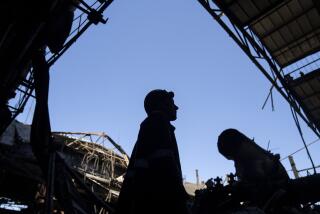‘Bunker-Busters’ Aim at Heart of Leadership
WASHINGTON — Carrying the allied air war to the innermost sanctuaries of the Yugoslav leadership, NATO warplanes have begun bombing a labyrinthine network of underground command bunkers with munitions designed to destroy the most well-protected targets.
Almost two weeks after blasting one of President Slobodan Milosevic’s Belgrade residences, NATO warplanes used a 5,000-pound “bunker-buster” bomb this week to strike another of his regular retreats: the national command center at Mt. Avila, just southeast of the capital. Military leaders said they have hit additional command sites in recent days but do not know the extent of damage.
“As we find those that are occupied or useful, or important, we’ll attack those too,” Air Force Maj. Gen. Charles Wald, a senior planner with the Joint Chiefs of Staff, said at a Pentagon briefing Tuesday.
Although there is no indication that Milosevic was at Mt. Avila at the time of the attack, NATO officials believe that he moves regularly among bunkers in the Belgrade area to avoid detection.
NATO and U.S. officials insist that they are not targeting Milosevic, top aides or family members personally and intend only to disrupt the command centers that guide military operations in Kosovo, a province of the Yugoslav republic of Serbia.
“We do make sure that when we target bunkers, we target those which are of technical or strategical interest,” German Air Force Gen. Walter Jertz said at a NATO briefing in Brussels.
Yet analysts said the broadening of targets is an attempt to bring the war closer to home. Hitting the bunker network is likely to get the leadership’s attention: It has been precious to Yugoslav rulers since it was begun by Marshal Josip Broz Tito after World War II.
Yugoslavia has, in fact, become so adept at bunker-building that during the 1980s, it sent specialists to Iraq to construct the underground facilities that the United States and its allies bombed during the 1991 Persian Gulf War.
The Mt. Avila bunker is a multistory center more than 100 feet underground, with communication equipment, medical facilities, living quarters and enough food to last for months. The center is capable of accommodating the entire Yugoslav general staff, officials of the Defense Ministry and other top civilian leaders, including Milosevic, experts say.
And the Yugoslav military has dozens of other such underground facilities scattered across the country to help it direct the resistance if the nation is invaded.
Tito began building the network after World War II because of his fears that Yugoslavia could come under nuclear attack by either the Soviet Union or the West. Since the threat of the Cold War receded, the bunkers have been adapted for conventional warfare.
Last Friday, NATO warplanes used the bunker-buster to blow up the tunnels of an underground shelter near the airport at Pristina, the capital of Kosovo. The facility housed up to two squadrons of MIG-21 fighters. The strike marked the first use of the munition, which was widely employed in the Gulf War.
The Yugoslav military also built huge shelters on the Dalmatian coast to protect smaller ships of the country’s navy, such as torpedo boats and submarines, said Milan Vego, a former Yugoslav military officer.
Yet these are not well sheltered from modern weaponry and probably could “be taken out by any plane with a modern missile,” said Vego, who now teaches at the U.S. Navy War College.
Tito envisioned using the bunkers as command posts to battle an invader in a protracted partisan struggle. For that reason, he placed many of them in mountainous Bosnia-Herzegovina.
During Bosnia’s war earlier this decade, one of the bunkers served as headquarters for Ratko Mladic, commander of the Bosnian Serb military.
The Yugoslav bunkers are said to be relatively spartan. Yet some analysts say that the best-outfitted among them would be very hard for the North Atlantic Treaty Organization to destroy, even with its deep-reaching bombs.
The most sophisticated have multiple backup systems of communications and electricity and can continue to function through repeated bombings.
“They have five or six layers of redundancy,” said Charles Heyman, a retired British officer and editor of “Jane’s World Armies.” “These people are very, very clever.”
On the Web
Extended coverage of the crisis in Yugoslavia is available at The Times’ Web site at http://161.35.110.226/yugo. Coverage includes hourly updates, all Times stories since NATO launched its attack, video clips, information on how to help the refugees, a primer on the conflict and access to our discussion group.
More to Read
Sign up for Essential California
The most important California stories and recommendations in your inbox every morning.
You may occasionally receive promotional content from the Los Angeles Times.











